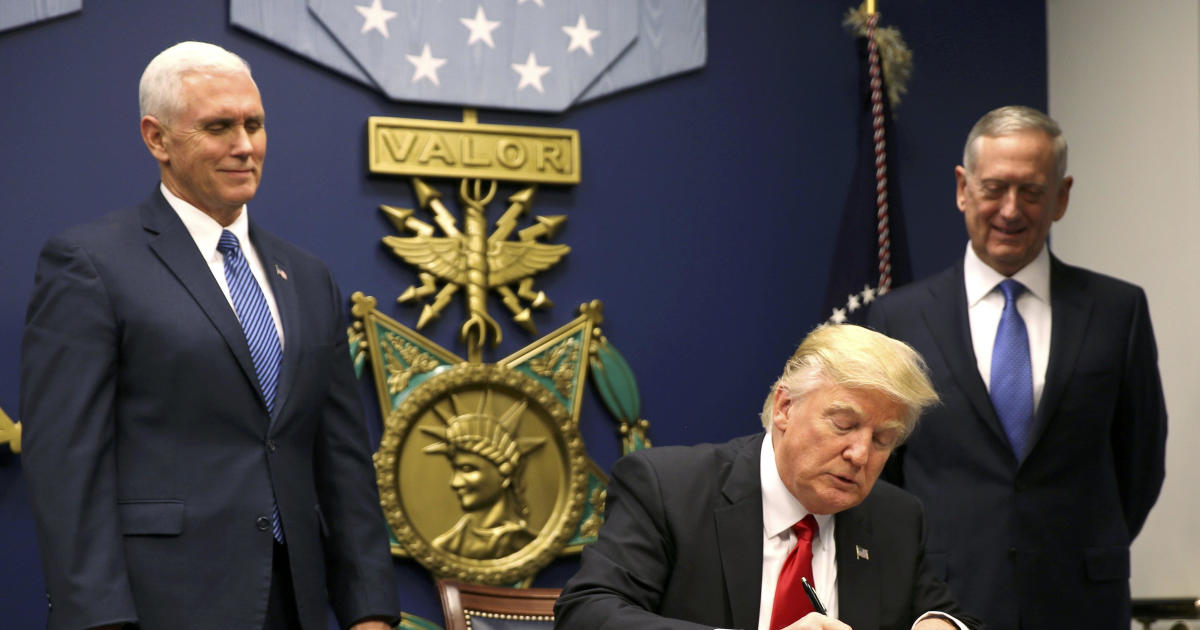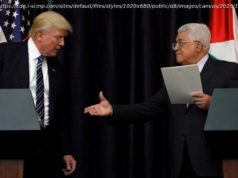 Last Updated Jan 28, 2017 11:01 AM EST
Last Updated Jan 28, 2017 11:01 AM EST
President Trump has been in office for a week and has taken advantage of his executive powers by beginning to craft and impose his administration’s policies.
Seven days into his first term, Mr. Trump has issued more than a dozen executive actions, which include a government-wide freeze on new and pending regulations, the reinstatement of a policy that bars U. S. funding to health providers abroad that discuss abortion as an option and a call for the construction of a physical wall along the U. S.-Mexico border.
Most of the actions taken so far are technically presidential memoranda, and four have been executive orders, which have the force of law and must be published in the Federal Register. Historically, presidents have embraced the executive order as a tool to use when there’s a lack of action from Congress. Some have been infamously contentious — President Franklin Roosevelt signed one in 1942 that established internment camps during World War II.
President Trump is expected to sign executive actions Wednesday to enable construction of a Mexico border wall. But questions remain about fundin…
Mr. Trump issued an executive order Friday that temporarily bans immigration to the U. S. from seven predominantly Muslim countries and indefinitely suspends the Syrian refugee program. The president said in his order that their entry “would be detrimental to the interests of the United States.”
Julian Zelizer, history and public affairs professor at Princeton University, said of the order, “The power of the president on national security is vast, especially post-9/11.” But he went on to say, “I’m sure that will be challenged.”
Here are some of the major actions that Mr. Trump has taken so far:
Within hours of being sworn in a week ago, Mr. Trump signed his first executive order , which seeks to “minimize the unwarranted economic and regulatory burdens” of the Affordable Care Act (ACA).
The order directs the head of Health and Human Services and other departments to use their authority to “waive, defer, grant exemptions from or delay the implementation of any provision or requirement of the act that would impose a fiscal burden on any state or cost, fee, penalty, or regulatory burden on individuals, families, healthcare providers, health insurers patients, recipients of healthcare services, purchasers of health insurance or makers of medical devices, products and medications.”
Mark Peterson, chairman of the Public Policy Department at UCLA, said that the order “is more of a planted flag” and that there are “significant constraints on what the president can do with an executive or domestic issue like this one.”
The Trump administration could change rules related to Obamacare, Peterson said, that were developed as part of the regulatory process. He pointed out, however, that any new, proposed regulations would have to comply with existing law and would be subject to a lengthy and complex process that would take months to implement them.
Kellyanne Conway called President Trump’s executive order on the Affordable Care Act a «great, big step towards replacing Obamacare» and promised…
“What the executive order does do is simply add further uncertainty to the process, which itself is something President Trump may wish to accomplish,” he said. “Uncertainty unnerves insurance companies, and that may lead to eventual market withdrawals and more destabilization of the market. That could lead to market collapse. Then the administration and Republicans will strive to claim that Obamacare collapsed under its own weight.”
Robert J. Blendon, professor of health policy and political analysis at Harvard’s School of Public Health, agrees that the order itself is not going to affect many people, but it does have enormous significance politically.
“If I am a governor, a president of an insurance company, I’m somebody enrolling, I’m saying I don’t know what this thing does, but this is a signal that this new president places as job number one, getting rid of this law,” he said.
The talking points given to Congress by the White House said that one goal of this executive order was “to help get the mandates and penalties off the backs of the poorest and sickest Americans.” The ACA’s individual mandate requires that Americans purchase health care insurance or pay a penalty. But this provision was already somewhat weakened by the fact that the law gave the IRS no real ability to enforce the payment of the penalty. The only recourse the tax collecting agency has is to subtract the penalty from the taxpayer’s refund. And if the taxpayer isn’t entitled to a refund, the IRS can carry the penalty over to the following year.
During a visit to the Department of Homeland Security Wednesday, Mr. Trump signed an executive order that calls on the department’s secretary to “take all appropriate steps to immediately plan, design, and construct a physical wall along the southern border, using appropriate materials and technology to most effectively achieve complete operational control of the southern border.”
But it won’t be that simple. Philip Schrag, a Georgetown law professor whose expertise includes immigration policy, said the U. S. doesn’t own all of the land adjacent to the border.
“In Texas, apparently there are a great many of the lands adjacent to the border in private hands, so the government would first have to seize the land by eminent domain or purchase it from the owners and then deal with the construction problems,” he said.
The order also calls on the DHS secretary to identify and allocate funding for the wall’s construction and prepare long-term budget requests to submit to Congress. House Speaker Paul Ryan is already on board and ready to work with the president to fund the wall. Mr. Trump also called for the hiring of 5,000 more Border Patrol agents and the construction of detention facilities near the U. S. border with Mexico, although that is dependent on Congress allocating money for the hires.
Schrag added that the migration of animals along the border will also pose an obstacle to building the wall and the U. S. will have to spend years funding this project.
“The challenges of building a physical wall in that terrain are going to mean that this is an extremely expensive project, requiring billions of dollars of appropriations over a period of years,” he said.
Mr. Trump signed another executive order Wednesday that intends to allow the attorney general and homeland security secretary to make a determination whether certain cities, known as “ sanctuary cities ,” are not eligible for federal grants. Schrag, however, said that the order doesn’t make sense because it says states and cities can’t receive federal grants if they willfully refuse to comply with the law, U. S. Code 1373.
“That’s a little bit puzzling because that subsection of the U. S. Code doesn’t actually require the cities to maintain any information about the immigration status of people they apprehend or people living in the cities,” he said. “It only prohibits the officials of states and governments from refusing to send such information to the Department of Homeland Security. It doesn’t require anybody to maintain that information. So if the city of New York apprehends somebody for a misdemeanor, this section does not require it to inquire into that person’s immigration status.”
President Trump signed an order to strip «sanctuary cities» of federal funding. Denver Mayor Michael Hancock joins CBSN to explain why he find…
The order also says the DHS must prioritize deportations for people in the U. S. illegally who have been convicted of a criminal offense, have been charged with one, have engaged in fraud and abused any program related to public benefits, among other criteria. It also calls for the hiring of 10,000 more immigration officers, which Congress would have to agree to allocate funding for.
Many mayors are resisting the threat posed by the executive order, though not all. Fearing a loss of millions of dollars from the federal government, Miami-Dade Mayor Carlos Gimenez ordered county jails to begin complying with federal immigration detention demands. The move effectively unravels Miami-Dade’s status as a “sanctuary” for the undocumented.
A memorandum Mr. Trump issued Monday imposed a freeze on all federal civilian employees “across the board” in the executive branch.
Beginning last Sunday, no vacant positions were allowed to be filled and no new positions could be created “except in limited circumstances.” The memorandum does not apply to military personnel, and it instructed the director of the Office of Management and Budget to develop a long-term plan “to reduce the size of the federal government’s workforce through attrition.






